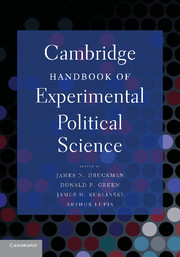Book contents
- Frontmatter
- Contents
- List of Tables
- List of Figures
- Contributors
- Acknowledgments
- INTRODUCTION
- PART I DESIGNING EXPERIMENTS
- PART II THE DEVELOPMENT OF EXPERIMENTS IN POLITICAL SCIENCE
- 6 Laboratory Experiments in Political Science
- 7 Experiments and Game Theory's Value to Political Science
- 8 The Logic and Design of the Survey Experiment
- 9 Field Experiments in Political Science
- PART III DECISION MAKING
- PART IV VOTE CHOICE, CANDIDATE EVALUATIONS, AND TURNOUT
- PART V INTERPERSONAL RELATIONS
- PART VI IDENTITY, ETHNICITY, AND POLITICS
- PART VII INSTITUTIONS AND BEHAVIOR
- PART VIII ELITE BARGAINING
- PART IX ADVANCED EXPERIMENTAL METHODS
- AFTERWORD
- Name Index
- Subject Index
- References
7 - Experiments and Game Theory's Value to Political Science
Published online by Cambridge University Press: 05 June 2012
- Frontmatter
- Contents
- List of Tables
- List of Figures
- Contributors
- Acknowledgments
- INTRODUCTION
- PART I DESIGNING EXPERIMENTS
- PART II THE DEVELOPMENT OF EXPERIMENTS IN POLITICAL SCIENCE
- 6 Laboratory Experiments in Political Science
- 7 Experiments and Game Theory's Value to Political Science
- 8 The Logic and Design of the Survey Experiment
- 9 Field Experiments in Political Science
- PART III DECISION MAKING
- PART IV VOTE CHOICE, CANDIDATE EVALUATIONS, AND TURNOUT
- PART V INTERPERSONAL RELATIONS
- PART VI IDENTITY, ETHNICITY, AND POLITICS
- PART VII INSTITUTIONS AND BEHAVIOR
- PART VIII ELITE BARGAINING
- PART IX ADVANCED EXPERIMENTAL METHODS
- AFTERWORD
- Name Index
- Subject Index
- References
Summary
In recent decades, formal models have become common means of drawing important inferences in political science. Best practice formal models feature explicitly stated premises, explicitly stated conclusions, and proofs that are used to support claims about focal relationships between these premises and conclusions. When best practices are followed, transparency, replicability, and logical coherence are the hallmarks of the formal theoretic enterprise.
Formal models have affected a broad range of scholarly debates in political science – from individual-level inquiries about why people vote as they do, to large-scale studies of civil wars and international negotiations. The method's contributions come when answers to normative and substantive questions require precise understandings about the conditions under which a given political outcome is, or is not, consistent with a set of clearly stated assumptions about relevant perceptions, motives, feelings, and contexts. Indeed, many formal modelers use mathematics to sort intricate and detailed statements about political cause and effect by the extent to which they can be reconciled logically with basic premises about the people and places involved.
Formal models in political science have been both influential and controversial. Although no one contends that explicitly stated assumptions or attention to logical consistency are anything other than good components of scientific practice, controversy often comes from the content of formal models themselves. Many formal models contain descriptions of political perceptions, opinions, and behaviors that are unrealistic. Some scholars, therefore, conclude that formal models, generally considered, are of little value to political science.
- Type
- Chapter
- Information
- Cambridge Handbook of Experimental Political Science , pp. 89 - 101Publisher: Cambridge University PressPrint publication year: 2011
References
- 4
- Cited by

